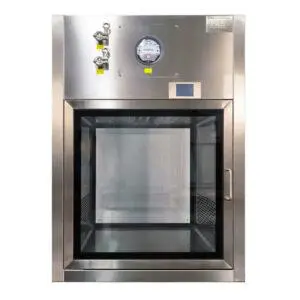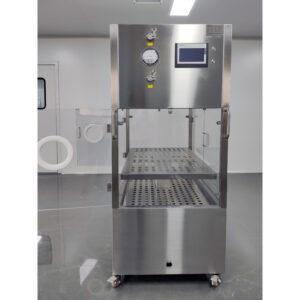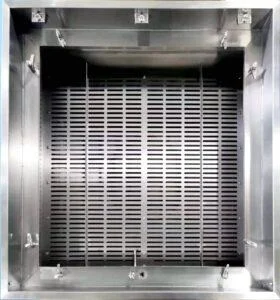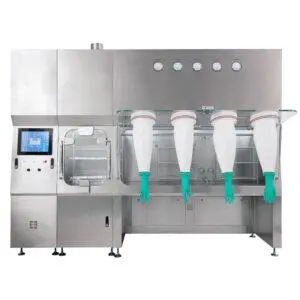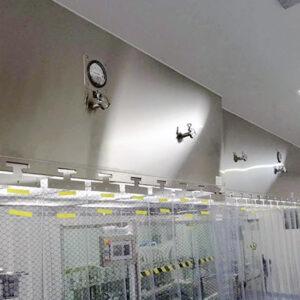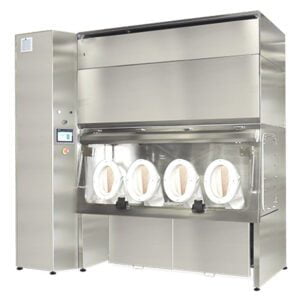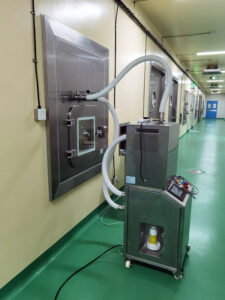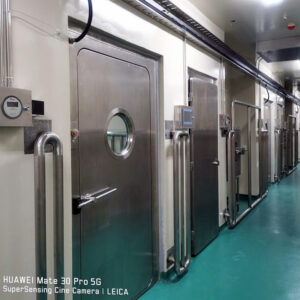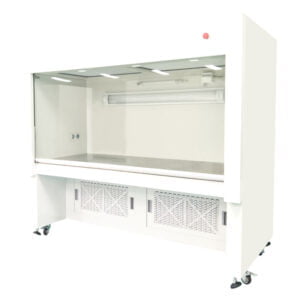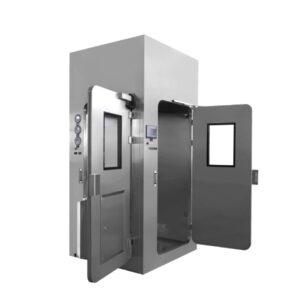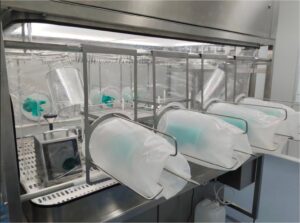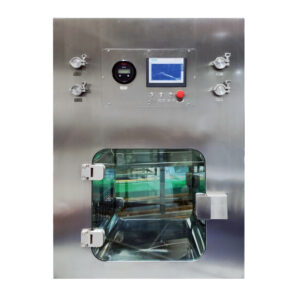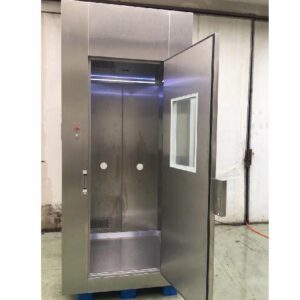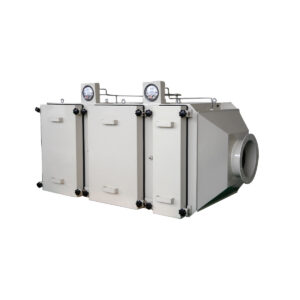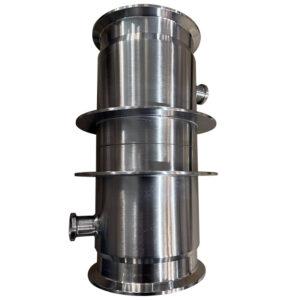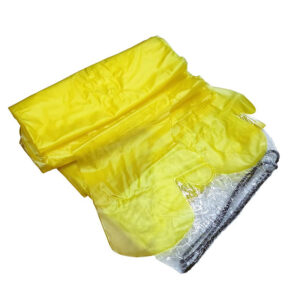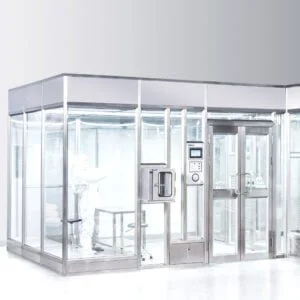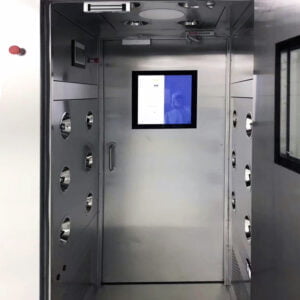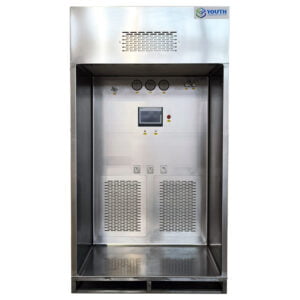Look, I’m just going to say it upfront – working with nuclear facilities is absolutely nerve-wracking, and honestly, it should be. I got a call about three weeks ago from a nuclear research facility that was having issues with their filter changeout procedures, and the conversation reminded me why I have such a love-hate relationship with this particular corner of the cleanroom industry.
The facility manager was basically panicking because their old BIBO (bag-in-bag-out) system was approaching end-of-life, and they were realizing that not all containment systems are created equal when you’re dealing with radioactive particulate. “We need something that absolutely, positively won’t release contamination during filter changes,” he told me. And you know what? That’s not marketing speak or regulatory box-checking – that’s literally life-and-death stuff when you’re talking about radiation containment.
Here’s the thing about nuclear applications that I wish more people understood: the stakes are just fundamentally different. In a pharmaceutical cleanroom, if you mess up a filter change, yeah, you might contaminate a batch or fail a validation. That’s expensive and annoying (trust me, I’ve been there). But in nuclear facilities? You’re potentially exposing workers to radiation, creating environmental hazards, and dealing with regulatory consequences that make FDA inspections look like friendly chats.
Why Nuclear BIBO Systems Keep Me Up at Night (In a Good Way)
I’ve been working with cleanroom filtration equipment for about 15 years now, and certified nuclear BIBO manufacturing represents some of the most challenging and, honestly, fascinating work in our industry. The engineering tolerances are insane, the validation requirements are exhaustive, and there’s absolutely zero room for “that’s probably good enough.”
Let me give you a real example from a project I worked on last year. We were specifying BIBO units for a nuclear medical isotope production facility (these folks make the radioactive materials used in cancer treatments and diagnostic imaging). The initial specifications they sent over looked reasonable on paper – HEPA filtration, standard bag-in-bag-out housing, regulatory compliance documentation. Pretty straightforward, right?
Wrong. So wrong.
When we got into the details, it became clear that their exhaust air was carrying radioactive iodine isotopes, and standard HEPA filters, while great for particulate, aren’t designed to capture volatile radioactive gases. We ended up designing a hybrid system with carbon adsorption pre-treatment followed by HEPA/ULPA filtration, all integrated into a radiation containment BIBO system that could handle both particulate and gaseous radionuclides.
The project took about four months longer than initially planned (which frustrated everyone involved, including me), cost roughly 40% more than the original budget, and required validation testing that was more comprehensive than anything I’d done in pharmaceutical applications. But you know what? That system has been running flawlessly for over a year now, and workers are safely changing filters without any measurable radiation exposure.
That’s the kind of stuff that actually gets me excited about this work, even when it’s a pain in the neck to engineer.
What Makes Nuclear BIBO Units Different (And Why You Can’t Cheap Out)
Okay, so let’s talk about what actually separates nuclear-grade BIBO systems from the standard biosafety or pharmaceutical units that most cleanroom folks are familiar with.
Material Selection and Radiation Resistance
First off, material selection is critical. You can’t just use any old powder-coated steel housing and call it a day. Radiation exposure over time can degrade polymers, seals, and even some metals. I’ve seen gasket materials become brittle and crack after extended exposure to gamma radiation – not exactly what you want when containment is your primary objective.
For nuclear applications, we’re typically specifying stainless steel (usually 304 or 316 grade) for housing construction, with specialized radiation-resistant gaskets and seals. The filter media itself needs to maintain structural integrity under radiation exposure, which is why nuclear facilities often use all-glass HEPA filters rather than the standard fiberglass media you’d see in commercial cleanrooms.
(And before anyone asks – yes, all-glass filters are significantly more expensive. We’re talking roughly 2-3x the cost of standard commercial HEPA filters. But when you’re containing radioactive material, that’s just the price of doing business.)
Containment During Filter Changeout
Here’s where the BIBO design really earns its keep. The whole point of bag-in-bag-out systems is enabling safe filter replacement without exposing maintenance workers to whatever contamination the filter has captured. In nuclear facilities, that contamination might include alpha-emitting particles, beta radiation sources, or gamma-emitting isotopes.
The standard BIBO changeout procedure involves:
- Sealing the contaminated filter inside a plastic containment bag while it’s still installed in the housing
- Cutting the filter free from its mounting frame (still inside the sealed bag)
- Bagging the contaminated filter a second time for additional containment
- Installing a new filter using a reverse bag-in procedure
- Validating the new filter installation with leak testing
Sounds straightforward, right? But in nuclear applications, each of these steps needs to be performed under strict radiation safety protocols, often with continuous radiation monitoring, dose tracking for workers, and specialized contamination control procedures.
I watched a filter changeout at a nuclear facility last year that took nearly four hours from start to finish – compared to maybe 45 minutes for a similar procedure in a pharmaceutical cleanroom. The difference? Radiation surveys between each step, contamination wipe testing, and multiple levels of oversight to ensure nothing went wrong.
Was it tedious? Absolutely. Was it necessary? Also absolutely.
The Regulatory Nightmare (Or Why Nuclear BIBO Projects Take Forever)
Look, I’m not going to sugarcoat this – the regulatory requirements for nuclear BIBO systems are intense. Like, “make pharmaceutical GMP look straightforward” levels of intense.
Depending on the specific application and location, you might be dealing with:
- Nuclear Regulatory Commission (NRC) requirements in the US
- International Atomic Energy Agency (IAEA) standards
- Local radiation safety regulations
- Occupational dose limits and ALARA (As Low As Reasonably Achievable) principles
- Environmental discharge permits for air emissions
- Transportation regulations for radioactive waste (because those contaminated filters need to go somewhere)
I had a client once who was shocked – genuinely shocked – when I told him the complete design, fabrication, and validation timeline for their nuclear BIBO system would be about 14 months. “But we got a quote from another supplier who said they could do it in six months!” he protested.
You know what I told him? “Then they either don’t understand nuclear applications, or they’re planning to cut corners that will bite you during commissioning.”
Turns out I was right (not that I’m gloating or anything). They went with the other supplier, who delivered equipment that failed initial validation testing because the bag-in-bag-out sealing procedure didn’t maintain adequate containment during simulated filter changeouts. The whole system had to be re-engineered, which ended up taking… you guessed it… about 14 months from their original installation date.
If you’re dealing with similar challenges or planning a nuclear facility upgrade, feel free to reach out at [email protected] – I’m always happy to talk through project timelines and realistic expectations before you commit to a supplier who’s overpromising.
Real-World Nuclear Applications (And Why Each One is Different)
Here’s what bugs me about how some suppliers approach nuclear BIBO systems: they act like it’s a one-size-fits-all solution. “We make nuclear-grade BIBO units!” they’ll say, as if every nuclear application has the same requirements.
That’s complete nonsense.
Let me break down some of the different nuclear applications I’ve worked with and why each one needs a customized approach:
Nuclear Power Plants
These facilities are dealing primarily with particulate contamination from fuel handling areas, reactor maintenance zones, and contaminated equipment storage. The radioactive particles might include activated corrosion products, fuel particles, or fission products.
The BIBO systems for power plants typically need:
- Very high particulate efficiency (HEPA or ULPA grade)
- Robust construction for 24/7 operation
- Redundant systems for critical ventilation zones
- Integration with facility radiation monitoring systems
- Extremely reliable performance (because unplanned shutdowns cost millions)
Nuclear Medicine and Radiopharmaceutical Production
This is where things get chemically interesting. You’re not just dealing with particulate – you’ve got volatile radioactive compounds, organic solvents, and chemical processing byproducts.
I worked on a project for a radiopharmaceutical manufacturer producing PET imaging agents (that’s positron emission tomography, for anyone not familiar with nuclear medicine). The challenge? The radioactive fluorine-18 they were using exists as a gas at room temperature, so standard particulate filtration wasn’t sufficient.
We ended up designing a system with:
- Activated carbon beds for volatile radioactive compounds
- HEPA filtration for particulate capture
- Chemical resistant construction (because they were also using organic solvents)
- Expedited changeout procedures (because F-18 has a 110-minute half-life, so production timing is critical)
The whole system needed to capture both the radioactive isotopes AND meet VOC emission standards for the organic chemistry work they were doing. Talk about a multi-disciplinary headache.
Nuclear Research Facilities
Research facilities are, in my experience, the most challenging nuclear applications because the contamination sources are constantly changing. One month they’re working with tritium (a beta-emitting hydrogen isotope), the next month it’s plutonium research (alpha emitter, which is a whole different containment challenge).
For research applications, flexibility is key. We often design BIBO systems with:
- Modular filter banks that can be reconfigured
- Multiple-stage filtration for different isotope types
- Enhanced monitoring and alarm systems
- Documentation systems for experimental condition tracking
Nuclear Waste Processing
This is probably the most demanding application I’ve worked with. You’re dealing with the nastiest, most concentrated radioactive materials in the nuclear fuel cycle – the stuff that’s being prepared for long-term storage or disposal.
The contamination levels are orders of magnitude higher than operational nuclear facilities, which means:
- Multiple stages of HEPA filtration (often 3-4 stages in series)
- Pre-filters that need frequent replacement
- Extremely robust bag-in-bag-out procedures
- Remote monitoring and operation capabilities
- Shielding integration for high-radiation areas
I visited a nuclear waste processing facility once where the BIBO housing was installed behind a concrete wall with leaded glass viewing windows, and all filter changes were performed using remote manipulators. The maintenance technicians never directly touched the equipment – everything was done through mechanical arms and video monitoring.
That project was absolutely fascinating from an engineering perspective, and also completely reinforced my respect for the people who work in nuclear waste management. They’re dealing with challenges that most of us in the cleanroom industry never have to think about.
Design Features That Actually Matter (Based on Real Nuclear Experience)
Alright, let’s get into the nuts and bolts of what makes a good nuclear BIBO system. This isn’t marketing fluff – these are features that I’ve seen make the difference between successful installations and expensive failures.
Radiation Monitoring Integration
A proper nuclear BIBO system shouldn’t just be a passive filter housing. It needs active monitoring of the exhaust stream for radiation levels. Most systems I specify include:
- Continuous air monitors (CAMs) on the exhaust side
- Radiation alarms integrated with facility safety systems
- Data logging for regulatory compliance documentation
- Automatic shutdown procedures if radiation levels exceed setpoints
I’ve seen installations where this monitoring caught filter failures before they became serious containment breaches. In one case, a HEPA filter developed a small tear (probably from a manufacturing defect), and the downstream radiation monitor detected elevated levels within minutes. The system automatically shut down, containment was maintained, and we were able to replace the defective filter before any significant release occurred.
That’s the kind of safety redundancy that justifies the extra cost and complexity of proper nuclear BIBO systems.
Differential Pressure Monitoring and Alarms
Filter loading affects system performance, obviously, but in nuclear applications it also impacts safety. An overloaded filter can develop bypass paths, allowing contaminated air to escape around the filter media rather than through it.
Every nuclear BIBO system should have:
- Differential pressure gauges (magnehelic gauges or electronic transducers)
- High-pressure alarms indicating filter replacement is needed
- Low-pressure alarms indicating bypass conditions or system failures
- Trending and data logging for predictive maintenance
Here’s a quick comparison of how I typically set pressure differential limits for different applications:
| Application Type | Initial ΔP | High ΔP Alarm | Low ΔP Alarm | Typical Filter Life |
|---|---|---|---|---|
| Nuclear Power Plant | 0.8-1.0 in. W.G. | 3.0 in. W.G. | 0.3 in. W.G. | 12-18 months |
| Radiopharmaceutical | 0.8-1.0 in. W.G. | 2.5 in. W.G. | 0.3 in. W.G. | 6-12 months |
| Nuclear Research Lab | 0.8-1.0 in. W.G. | 3.0 in. W.G. | 0.3 in. W.G. | 8-15 months |
| Waste Processing | 1.0-1.2 in. W.G. | 4.0 in. W.G. | 0.4 in. W.G. | 3-6 months |
(Note: W.G. = inches of water gauge, the standard pressure measurement in HVAC applications. Also, these are rough guidelines based on my experience – your specific application might vary.)
The shorter filter life in waste processing isn’t a mistake – those pre-filters get hammered with high contamination loads and need frequent replacement. It’s expensive and labor-intensive, but that’s just the reality of that application.
Bag-In-Bag-Out Housing Design Details
The actual BIBO housing design matters more than most people realize. I’ve seen units that technically met the BIBO definition but were absolute nightmares to actually service.
Features I always look for:
Adequate bag volume: The containment bag needs to be large enough to fully enclose the contaminated filter without tearing during removal. I’ve seen installations where someone spec’d undersized bags to save money, and workers ended up fighting with torn bags during changeouts. Not acceptable when you’re dealing with radioactive contamination.
Smooth interior surfaces: Any sharp edges or protrusions inside the housing can puncture bags during filter installation or removal. The interior should be smooth, polished stainless steel with rounded corners.
Ergonomic access: Filter changeouts in full protective equipment (sometimes including respirators) is already challenging. The housing design should make the procedure as straightforward as possible, with clear access paths and intuitive mounting mechanisms.
Adequate lighting and visibility: This might sound minor, but trying to perform a bag-in-bag-out procedure in poor lighting is asking for mistakes. Good installations include supplemental LED lighting around the housing.
Tool-free or minimal-tool access: The fewer tools required for filter access, the fewer opportunities for dropped tools, stripped fasteners, or other mishaps during what’s already a high-stakes procedure.
Structural Considerations for Shielding
Depending on the radiation levels involved, BIBO housings might need to support significant weight from lead shielding, concrete barriers, or other radiation protection measures.
I worked on a project where the initial BIBO housing spec didn’t account for the shielding that would be added during installation. When the facility tried to attach lead-lined panels to the housing (to reduce radiation exposure during filter changes), the housing structure wasn’t adequate and started to deform.
We ended up having to fabricate a completely new housing with reinforced structural framing – an expensive lesson about the importance of understanding the complete installation requirements upfront, not just the filtration specifications.
Performance Validation (Why Testing Takes Forever but Matters)
Okay, I need to vent for a minute about validation testing. It’s tedious, time-consuming, expensive, and absolutely non-negotiable for nuclear applications.
The validation process for nuclear BIBO systems typically includes:
Factory Testing (Before Shipment)
- HEPA filter scan testing (DOP or PAO aerosol challenge)
- Pressure drop verification across the filter bank
- Housing pressure testing (to verify containment integrity)
- Bag-in-bag-out procedure simulation
- Radiation-resistant materials certification
- Welding quality testing (usually dye penetrant or radiographic inspection)
- Documentation package preparation
I usually budget about 2-3 weeks for comprehensive factory testing, and that’s with an experienced testing team. Rushing this phase is how defects slip through and cause problems during commissioning.
Site Installation Testing
Once the unit arrives at the nuclear facility, there’s a whole additional round of testing:
- Installation integrity verification
- Ductwork connection leak testing
- System airflow verification
- Radiation monitor calibration and testing
- Alarm system functional testing
- Differential pressure system verification
- Complete bag-in-bag-out procedure demonstration (usually observed by facility radiation safety staff)
- “As-built” documentation review
This phase typically takes 3-5 weeks, depending on facility access restrictions, radiation safety requirements, and coordination with other trades.
Operational Validation
Even after installation testing, there’s usually a period of operational validation where the system runs under actual process conditions with enhanced monitoring and documentation:
- Continuous radiation monitoring with documented results
- Regular contamination surveys
- Exhaust air sampling and analysis
- Filter loading rate measurement
- System performance trending
- Worker dose tracking during first filter changeout
- Documentation of any deviations or performance issues
This phase might run for 3-6 months before the facility considers the system fully validated and operational.
Yeah, it’s a long process. Yeah, it’s expensive. But would you want to be the person who skipped validation steps and later had a radioactive release because of a containment failure? I definitely wouldn’t.
Common Problems (And How I’ve Learned to Avoid Them)
Let me share some of the issues I’ve encountered over the years and how I approach them now:
Problem #1: Undersized Systems
Early in my career, I made the mistake of sizing a nuclear BIBO system based on the nominal airflow requirements without adequate safety factor. The system technically met the specifications but ran at near-maximum capacity, which meant:
- High energy costs
- Accelerated filter loading
- No capacity for upset conditions or process changes
- Difficulty maintaining negative pressure during high-demand periods
Now I typically oversize nuclear ventilation systems by at least 20-30% to ensure reliable performance under all operating conditions. It costs more upfront, but the operational benefits are worth it.
Problem #2: Ignoring Humidity Control
Here’s something that surprised me: humidity can significantly impact HEPA filter performance in nuclear applications, especially in coastal facilities or humid climates.
High humidity can cause:
- Increased filter pressure drop (as media absorbs moisture)
- Potential for microbial growth on filters (which can complicate radioactive waste disposal)
- Corrosion issues with metal housings and supports
- Difficulty with bag-in-bag-out procedures (moisture makes bags stick together)
I now always specify humidity control (dehumidification or humidity-resistant materials) for nuclear installations in humid environments. In one coastal nuclear facility, we added desiccant dehumidification upstream of the BIBO units, which extended filter life by about 40% and eliminated recurring corrosion issues.
Problem #3: Inadequate Filter Change Procedures
This is a big one. The BIBO system itself might be perfectly designed, but if the facility doesn’t have well-documented, well-practiced filter change procedures, you’re asking for contamination events.
I’ve started requiring comprehensive procedure development as part of nuclear BIBO projects:
- Written step-by-step procedures with photos
- Training sessions for maintenance personnel
- Mock changeout practice (with non-radioactive equipment)
- Validation of procedures under radiation safety oversight
- Regular refresher training (at least annually)
It adds time and cost to projects, but the first time you watch a smooth, professional filter changeout performed by a well-trained team, you realize it’s absolutely worth the investment.
If you’re struggling with developing effective filter change procedures or need help training your maintenance staff, drop me a line at [email protected] – I’ve accumulated a lot of procedure templates and training materials over the years that might save you some headaches.
Cost Reality Check (No One Wants to Talk About This, But Let’s Be Honest)
Alright, let’s talk money. Nuclear BIBO systems are expensive. Like, really expensive compared to standard cleanroom filtration equipment.
Here’s a rough comparison based on projects I’ve worked on recently (these are ballpark figures – your specific application will vary):
| System Type | Equipment Cost | Installation Cost | Annual Operating Cost | Total 10-Year Cost |
|---|---|---|---|---|
| Standard Pharmaceutical BIBO | $15,000-25,000 | $5,000-10,000 | $2,000-3,000 | $45,000-75,000 |
| Nuclear BIBO (Low-Level) | $40,000-65,000 | $15,000-25,000 | $8,000-12,000 | $135,000-185,000 |
| Nuclear BIBO (High-Level) | $80,000-150,000 | $30,000-50,000 | $15,000-25,000 | $280,000-450,000 |
| Nuclear Waste Processing | $150,000-300,000+ | $50,000-100,000 | $30,000-50,000 | $550,000-900,000+ |
Why such a huge cost difference?
- Materials: Radiation-resistant materials, stainless steel construction, specialized gaskets and seals
- Engineering: Custom design work, computational modeling, safety system integration
- Testing: Comprehensive factory and field testing, validation documentation
- Compliance: Regulatory submittals, nuclear safety reviews, licensing support
- Installation: Specialized contractors, radiation safety oversight, extended commissioning
- Operations: Specialized filters, radioactive waste disposal costs, enhanced monitoring
Is it expensive? Absolutely. But here’s the thing – the cost of a contamination event, radiation exposure, or regulatory enforcement action is orders of magnitude higher than the cost of doing it right the first time.
I’ve seen facilities try to cheap out on nuclear BIBO systems, and it never ends well. Either they end up with equipment that doesn’t meet regulatory requirements (and has to be replaced), or they have performance issues that compromise safety and create expensive remediation needs.
My honest advice: if you can’t afford to do nuclear BIBO properly, you might need to reconsider whether your facility is ready for radioactive material operations. This isn’t an area where “good enough” is acceptable.
Working with Suppliers (How to Separate Nuclear Experience from Marketing Claims)
Here’s something that frustrates me: the number of suppliers who claim nuclear capability based on minimal actual experience. Manufacturing a HEPA filter housing doesn’t make you qualified for nuclear applications – it’s a completely different ballgame.
When evaluating suppliers for nuclear BIBO equipment, here are the questions I actually ask:
Experience Verification
- “How many nuclear installations have you completed in the past five years?” (I want specific numbers, not vague claims)
- “Can you provide reference contacts at nuclear facilities?” (and then I actually call them)
- “What’s your experience with [specific isotope or application relevant to my project]?”
- “What nuclear regulatory approvals or certifications does your equipment hold?”
Technical Capability
- “Walk me through your approach to radiation-resistant material selection.”
- “How do you validate bag-in-bag-out containment effectiveness?”
- “What radiation monitoring integration experience do you have?”
- “Describe a difficult nuclear project and how you handled the challenges.”
Quality and Documentation
- “What quality management system do you operate under?” (I’m looking for ISO 9001 at minimum, preferably nuclear-specific QA programs)
- “What documentation package comes with the equipment?” (nuclear facilities need extensive documentation)
- “How do you handle nuclear material traceability requirements?”
- “What’s your approach to configuration management and change control?”
If a supplier can’t give confident, detailed answers to these questions, that’s a red flag. You want someone who’s genuinely experienced in nuclear applications, not someone treating it as just another cleanroom project.
Future Trends (What’s Actually Changing vs. Marketing Hype)
The nuclear industry moves slowly – which is probably a good thing when you’re dealing with radiation safety – but there are some legitimate developments worth paying attention to:
Small Modular Reactors (SMRs)
There’s a lot of buzz about SMRs as the future of nuclear power. From a BIBO system perspective, the interesting thing about SMRs is that they’re designed for factory fabrication and modular installation.
This might actually make nuclear BIBO equipment less expensive (crazy, right?) because systems can be designed, manufactured, and tested as integrated modules rather than custom one-off installations. I’m cautiously optimistic that this could bring nuclear-grade air handling equipment costs down by maybe 20-30% over the next decade.
Or it might not pan out at all. Time will tell.
Advanced Filtration Media
There’s ongoing research into advanced filter media that’s more radiation-resistant, has longer service life, or provides better capture efficiency for specific isotopes.
I’ve seen some interesting work on:
- Electrostatically enhanced HEPA filters optimized for radioactive particulate
- Hybrid carbon/HEPA media for simultaneous particulate and gas-phase capture
- Nanofiber filter media with improved radiation stability
Will any of this become mainstream? Honestly, I don’t know. The nuclear industry is (appropriately) conservative about adopting new technologies, so even promising developments might take 10-15 years to gain widespread acceptance.
Remote Operation and Maintenance
This is probably the most realistic near-term development. The ability to monitor, operate, and even perform some maintenance activities remotely reduces worker radiation exposure and improves operational efficiency.
I’m seeing increasing interest in:
- Remote filter differential pressure monitoring with predictive maintenance algorithms
- Automated bag-in-bag-out systems that minimize hands-on worker involvement
- Robotic or semi-robotic filter changeout systems
- Advanced radiation monitoring with real-time data analytics
YOUTH Clean Tech has been exploring some of these technologies, and I think we’ll see increasing adoption over the next 5-10 years, especially in high-radiation applications like waste processing.
The Human Element (Because Equipment is Only Part of the Story)
You know what really determines the success of nuclear BIBO systems? The people operating and maintaining them.
I’ve seen technically perfect installations fail because facility staff weren’t properly trained or didn’t understand the critical nature of their work. And I’ve seen older, less-than-ideal equipment perform safely for decades because the maintenance team was absolutely committed to doing things right.
Some observations from years of working with nuclear facility personnel:
Culture of Safety
Nuclear facilities that take radiation safety seriously have a fundamentally different culture than facilities where it’s treated as a compliance checkbox. You can feel it when you walk in – the attention to detail, the questioning attitude, the unwillingness to take shortcuts.
That culture directly impacts BIBO system performance. When workers understand why bag-in-bag-out procedures matter, they perform them carefully and correctly. When it’s just another task to check off, mistakes happen.
Training Investment
The best nuclear facilities invest heavily in training – not just initial qualification, but ongoing practice, refresher training, and continuous improvement of procedures.
I remember visiting a facility where they performed mock filter changeouts quarterly, even though actual filter changes only happened once or twice a year. “We want muscle memory,” the maintenance supervisor told me. “When we’re working with hot filters, we don’t want anyone thinking about the steps – we want it to be automatic.”
That’s the level of commitment that keeps people safe.
Maintenance Team Empowerment
In good nuclear facilities, maintenance personnel have the authority to stop work if something doesn’t seem right, question procedures, and suggest improvements. There’s no pressure to rush through filter changes or skip validation steps.
I’ve watched filter changeouts get paused because someone noticed a bag that looked slightly torn. Better to take an extra hour and get a new bag than risk a contamination release – and the facility culture supported that decision completely.
Practical Recommendations (What I’d Tell Someone Starting a Nuclear BIBO Project Today)
Alright, if you’re actually planning a nuclear BIBO project, here’s my condensed wisdom from years of doing this:
1. Start with a thorough hazard assessment
Don’t assume you understand the contamination sources. Work with radiation safety staff, process engineers, and operations personnel to fully characterize what the BIBO system needs to contain. Include worst-case scenarios, not just normal operation.
2. Engage regulatory authorities early
Don’t design and build a system and then ask if it meets regulatory requirements. Have preliminary discussions with NRC (or your local regulatory body) to understand their expectations and any site-specific requirements.
3. Budget realistically
Use the cost estimates I provided earlier as a starting point, and add contingency. Nuclear projects always encounter unexpected challenges. I typically recommend 20-30% contingency for nuclear BIBO installations.
4. Plan for long lead times
From initial design to operational system, expect 12-18 months minimum, possibly 24+ months for complex applications. Anyone promising faster delivery either doesn’t understand nuclear requirements or is cutting corners.
5. Invest in training
Don’t treat training as an afterthought. Budget for comprehensive initial training, procedure development, mock changeout practice, and ongoing refresher training. This might be 10-15% of your total project cost, and it’s worth every penny.
6. Document everything
Nuclear facilities live and die by documentation. Ensure your supplier provides comprehensive documentation, and supplement it with site-specific procedures, training records, maintenance logs, and validation records.
7. Plan for disposal
Those contaminated filters need to go somewhere. Make sure you understand radioactive waste classification, disposal pathways, and costs before you start operations. Disposal costs can be shockingly high – sometimes $5,000-20,000+ per filter depending on contamination levels.
8. Consider life-cycle costs
The initial equipment cost is just the beginning. Annual operating costs (filters, disposal, maintenance, monitoring) often exceed the initial capital cost over the system’s lifetime. Make decisions based on total cost of ownership, not just purchase price.
Final Thoughts (Because I’ve Rambled Long Enough)
Look, nuclear BIBO systems are challenging, expensive, and absolutely critical for safe operations involving radioactive materials. They’re not the kind of equipment you can treat casually or try to value-engineer into mediocrity.
But here’s what I genuinely love about this work: when it’s done right, these systems protect workers from serious health hazards, enable beneficial uses of nuclear technology (like cancer treatment), and demonstrate that we can safely handle one of nature’s most powerful and dangerous forces.
Every time I see a smooth filter changeout where workers stay well below dose limits, every time a radiation monitor catches a potential issue before it becomes a problem, every time a facility operates for years without a contamination incident – that’s when I remember why this work matters.
Is it perfect? No. Are there challenges, frustrations, and things that keep me up at night? Absolutely. But the alternative – treating nuclear contamination control as “just another cleanroom application” – is completely unacceptable.
If you’re working on nuclear applications and want to talk through design challenges, supplier selection, or regulatory requirements, I’m always happy to chat. Feel free to reach out at [email protected] – I may not have all the answers, but I’ve made enough mistakes over the years to help you avoid some of the common pitfalls.
And if you’re a nuclear facility operator reading this – thank you for taking contamination control seriously. The work you do to keep facilities safe often goes unrecognized, but it’s absolutely vital.
Stay safe out there, and don’t cheap out on your BIBO systems.
References:
[1] International Atomic Energy Agency (IAEA). “Design of Ventilation Systems for Nuclear Facilities.” IAEA Safety Standards Series No. NS-G-1.10, 2003.
[2] U.S. Nuclear Regulatory Commission. “High-Efficiency Particulate Air Filter Units.” Regulatory Guide 3.12, Rev. 2, 2001.
[3] American National Standards Institute/American Society of Mechanical Engineers. “Nuclear Facilities – Testing of Nuclear Air Treatment, Heating, Ventilating, and Air Conditioning Systems.” ANSI/ASME N510-2007.
Related Contents:
- Nuclear Facility HEPA Housing Box Safety Protocols 2025
- BIBO Systems in Nuclear Facilities: Safety First
- Nuclear Safety Revolution: BIBO Systems Enhance Protection
- Bag-In/Bag-Out (BIBO) Systems: Operation and Maintenance Guide
- Bag In Bag Out Systems | Safety Fundamentals Explained
- Safe Chemical Handling with BIBO Systems
- Understanding BIBO | Hazardous Material Containment
- BIBO System Basics | Bag In Bag Out Filter Principles
- BIBO Systems: Ensuring Food Safety in Processing





